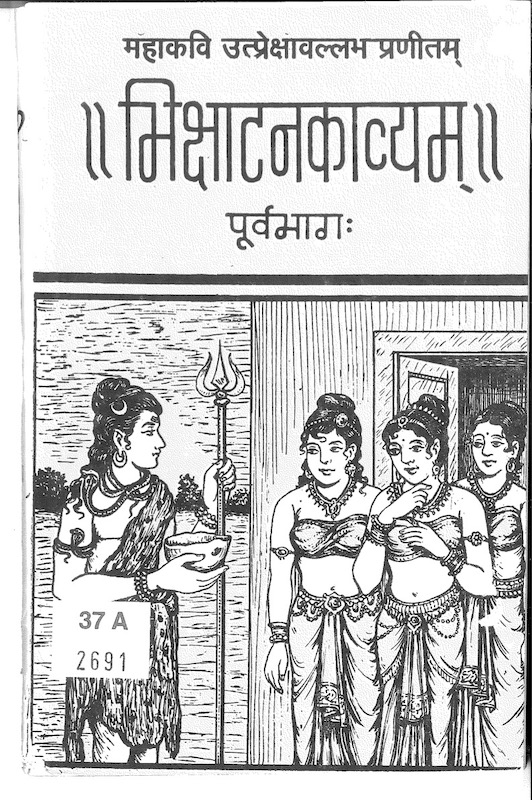
On March 11th I had the pleasure to inaugurate the new series of our Śivadharma Project seminar, with an online talk attended by the members of the project and a few guests. This has been the first occasion to introduce to the two new members of the project the research that I have been conducting for the past year.
My research, co-funded by the University of Bologna, enjoys a hybrid status compared to the “hardcore” Śivadharma exegesis brought on by my colleagues. Dealing with South Indian kāvya, I have to develop a special sensitivity to identify even the smallest hints of religious theory and practice within absolutely mundane texts. This puts my research on the trail of the most recent developments in the study of kāvya, which aim at putting classical poetry in a broader context, juxtaposing its literary appreciation to new methods of analysis that are able to transform it into an unexpected source of information on the social and religious life of the period.
My critical edition of the first three cantos of Utprekṣāvallabha’s Bhikṣāṭanakāvya,the Poem on Śiva as the Beggar composed in South India in the 13th century, with the unpublished commentary by King Maṅgapa of Ummattur (Karnataka, 16th century) has now reached a stage where I can summarise some of my findings and focus on the most interesting challenges raised by the texts. My work is based at the moment on a single palm leaf manuscript which I have collected in Mysore. This manuscript, written in Nandināgarī script, is in poor conditions, but allows nonetheless to be read almost integrally. Three more copies of Maṅgapa’s commentary exist in Berlin, but unfortunately are in such a bad shape that need some restoration before being able to be consulted.
One of the main questions concerns the genre to which the work belongs: Indian scholars rank it amongst the koṣas, “anthologies”, a label usually attributed to compilations, while this text is explicitly the work of one author. Moreover, the plot, however feeble it may be, follows a clear development: Śiva, in order to expiate the sin of killing Brahmā, wanders for alms around the world, making all the women of the earth fall in love with him. The poem consists in the description of the longings, gestures, thoughts of the enamoured ladies. Still, Indian readers in the past have felt free to rework the Bhikṣāṭanakāvya, adding individual stanzas, or complete sections within the poem in order to improve it or to serve different purposes: the most interesting case is a manuscript from the Government Oriental Manuscript Library, Madras, that contains two additional sections describing the Coḷa country, apparently visited by Śiva in his wanderings!
When working on a kāvya, it is of fundamental importance to remember that poets operated in a thick network of literary references, constantly recalling and rivalling with other authors, in an elegant game of quotations and allusions often spanning several centuries of literary history. So, the work on the sources plays a key role. If the plot of the Bhikṣāṭanakāvya comes from Puranic stories (especially from the Śaiva Kūrma Purāṇa), the main literary influence for Utprekṣāvallabha is constituted by the works of Kālidāsa, especially those poems (such as the Kumārasambhava and the Raghuvaṃśa) containing erotic scenes, marriage preparations and parades, detailed descriptions of feminine beauty. It is impressive to realise how closely Utprekṣāvallabha has followed Kālidāsa in certain stanzas, and at the same time, how originally and skilfully he had brought new lymph to the language of lyrical love poetry.
But for this research the problem of the sources is double, as I have to deal with both the main text and the commentary. Therefore, I have to pay particular attention to the quotations present in Maṅgapa’s gloss, in order to understand better his cultural milieu, the texts that framed his theoretical background, and the reference works he consulted to compose his work. This 16th century king shows an impressive amount of readings, ranging from the canonical works of grammar, lexicography and aesthetics, to the developments of the little studied Andhra school of poetics that were more close to him in place and time.
To conclude the seminar, which benefited of the observations, questions, and comments by all my colleagues, I have brought up two facts that particularly caught my attention while reading the texts. Both concern two specific aspects of Śaivism in both the poem and commentary.
In a few stanza of the poem, Utprekṣāvallabha extols the sensual qualities of women through the description of ascetics that can’t resist the temptations of love. This confers a humorous tone of parody to the poem, but we should not take it as a critique towards the ascetic world. Śaiva renunciants, in the course of Sanskrit literature, and especially in theatrical plays and farces, have often served the role of comic counterparts, described in the act of indulging in their sexual practices, or to scare the reader with the description of their gruesome Tantric rituals. Utprekṣāvallabha demonstrates once more to be receptive of literary echoes spanning genres and eras.
Finally, a big question arises as for what concerns the real scope of this commentary: was it a mere literary exercise, an erudite divertissement by a king who enjoyed poetry, or an intellectual task with deeper consequences and scopes?
In his introduction to the commentary, Maṅgapa states that, after being initiated by his teacher Pañcākṣara, he composed under his instruction an otherwise unknown Prasādaliṅgārpaṇasadbhāva. Judging from the title alone, the book seems to have been either a commentary on the seventh section of Māyideva’s Anubhavasūtra, the founding scripture of Vīraśaivism, or some other text related to the topic. Maṅgapa was therefore part of that tradition that saw his climax exactly in his place and time, Was the commentary on the Bhikṣāṭanakāvya too composed according to his teacher’s instructions? Was it therefore part of a programme of lay Śaivism were commenting on kāvya could serve as devotion? It is clear that the Poem of the Beggar artistically blends mundane occupations and religious practice, two aspects of life that may contrast, coexist, and even play together.
As Utprekṣāvallabha (Bhikṣāṭanakāvya 2.8) himself says:
There’s no doubt, enjoying the hips of a beautiful girl
is much better than Liberation, we have the proof:
look at those “liberated” ones, they got caught again, and all by themselves!
in the strings of the belt of a girl with pretty eyes.
mukter api priyatamājaghanopabhogaḥ
śreyān na mṛgyam iha vastuni naḥ pramāṇam |
yat paśyatāyatadṛśo raśanākalāpe
muktā api svayam aho punar eva baddhāḥ ||

